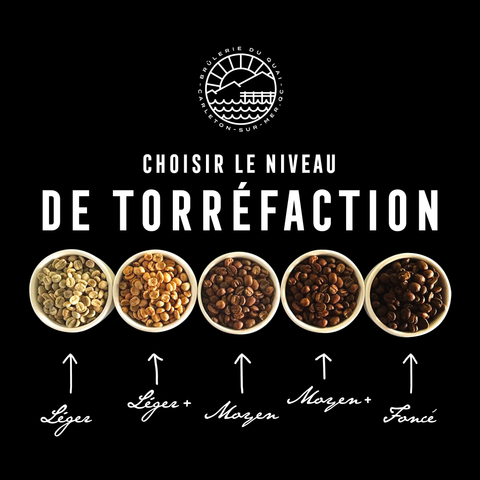This week we tasted a new batch of coffee. A Brazilian Cerrado screen 19, natural dry process, with the special mention SSFC. SS for “Strictly Soft” and FC for “Fine Cup”. In short, one of the best grains that can come out of the gigantic Brazilian machine, one of the main producers in the world.
We roasted this bean on Tuesday, lightly, in order to satisfy the delicate palates of our customers ;-) The next day, we proceed with the usual piston tasting. Interesting but still too close to roasting. Two days later, same stage, and then it becomes captivating. Toasted hazelnut, caramel, nice texture. Very promising. We then try it as an espresso. Ouch! Flavor of monkey ass and ajax. Okay, I'm exaggerating a little but it was really bad and I'm a picky eater. Panic. My team looks at me strangely since I bought this batch to include in our most popular espresso blends...
We then start the piston tests again. Remarkable result! We therefore conclude that there is something wrong with the espresso set-up. I did the espresso test again, and the cup was different from last time, not really good but different. I then jump on the mill for an inspection. I notice the grinder makes a slightly different sound. So I decide to inspect the millstones. I remove the cone, empty all the coffee and remove the upper burr.
Surprise! A rock in my mill! 
I then remove the parasite, close everything, readjust the burrs, put the coffee back in and make myself a shot of espresso. And There you go! My espresso then tastes what it should taste like and reassures me about my purchase. Brazil makes a really good espresso, full of texture with a hint of hazelnut, very soft and pleasant.
The damn stone, the size of a pea, therefore modified the grind by fracturing the coffee bean in a chaotic manner and gave an uneven grind probably saturated with dust. A great case of 4M troubleshooting.
A rock in the coffee?
Yes, it happens. Very rarely but it happens even to the best. However, even when buying the best grains which have passed through a “destoner” for sorting before export, and for manual repicking, (see photo below of the sorting in the NAEB warehouse, Rwanda)

we always find small debris of all kinds in green coffee. The roaster's trained eye eliminates the majority. You can find corn kernels in Mexican cafes, for example. They are easy to spot because they “pop” and turn completely white. I would say that the most difficult to work with are natural coffees, especially those from the island of Sumatra. We buy grade 1 “triple pick” and we can occasionally find small pieces of wood, tiny fragments of concrete, a relic of the cherry processing method which gives so much character to these grains. Occasionally, we even find small nails, pieces of skewers, a fellow roaster has even found a piece of coconut. Legends haunt certain roasters with stories of teeth, human bones, bullets, precious stones, jewels and even children...

Some quality grinders have a magnet in the center of the cone, just before the burrs, to remove metal objects. The Malkhonigs, for example, are all equipped with them.
So I've been using coffee roasted by Brulerie du Quai (an excellent roaster by the way) for 8 years and this is the first time that an object has influenced and disrupted a grinder. This is easily correctable and I have never heard of a mill being seriously damaged by this type of problem.
This is a somewhat taboo subject among roasters because only the industrialists have a "destoner", and all the others can therefore be victims of a small stone which would have passed the vigilance of the master roaster.
Some roasters may put on a show and say they only buy premium beans, but that's what we do and we do find them on occasion. No one is safe from this inconvenience, and even with a destoner, a small stone the size of a pea and the same density as a coffee bean can pass through the system and end up in a mill.
I will then take advantage of this anecdote to make you aware of cleaning your mill. Get into the habit of completely clearing the wheels to clean them and check if anything is blocking them. Also clean these with a brush (I use a toothbrush) to remove the dust which accumulates between the teeth of the grinding wheels and which makes the edges of the wheel round and less sharp.
My goal is not to create a paranoid feeling among you because this situation happens very rarely. I have never received a call from customers telling me that a stone had blocked their mill but if this happened do not hesitate to call us. Moreover, you can see by browsing certain discussion forums that this situation is more common than you imagine, several people even report having found small stones in coffee roasted by Starbucks.
I'll leave you with this little video found on YouTube in which the guy cleans his mill with rice. This will give you an idea of the simplicity of the procedure. For my part, I use a toothbrush and a small vacuum cleaner. I also draw your attention to the fact that the wheels of a mill are sharp and can seriously injure you. In the video, we can clearly see the grinder plugged into the wall as our budding barista sticks his fingers in it. I laughed a lot but it was frankly unconscious.
Good week!


Comments (0)
There are no comments for this article. Be the first one to leave a message!